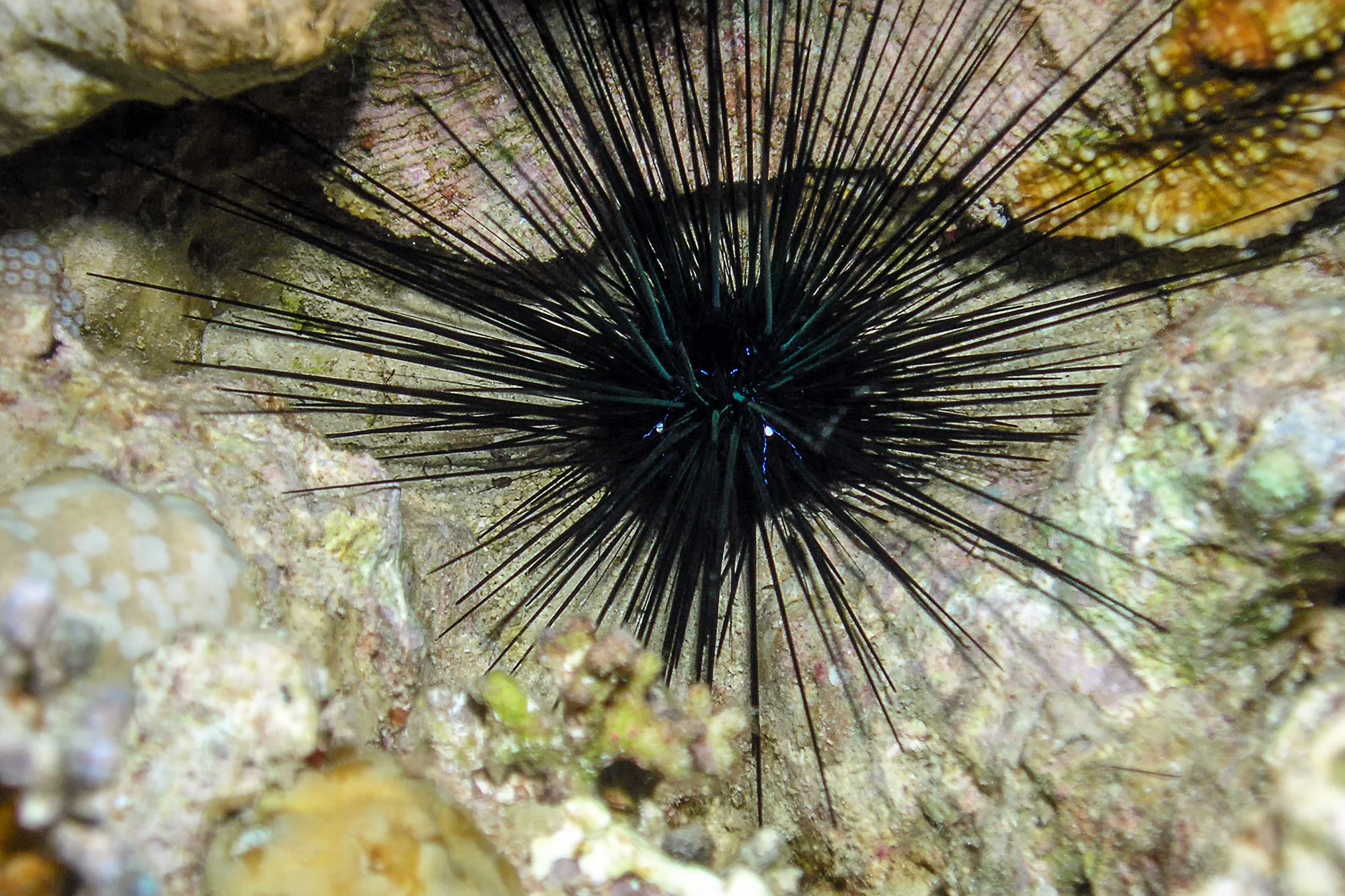Un organisme unicellulaire, le scuticocilié, a été identifié comme la cause de la mort massive en 2022 d’oursins à longues épines dans les Caraïbes et sur la côte est de la Floride. Ces oursins sont essentiels à la santé des récifs coralliens, et la découverte soulève des questions sur la présence de ciliés, leurs conditions de croissance et leur impact potentiel sur d’autres espèces. Photographie de l’oursin long et épineux (Diadema antillarum).
La mort massive de l’oursin à longues épines – une perte qui menace la santé des récifs coralliens des Caraïbes à la côte est de la Floride – a été causée par un organisme unicellulaire appelé cilié.
La chasse au tueur a pris fin en 2022 et a anéanti les oursins à longues épines dans les Caraïbes et le long de la côte est de la Floride. Une équipe de chercheurs organisée par Mia Breitbart, professeure émérite au Collège des sciences marines de l’Université de Floride du Sud, a identifié un organisme unicellulaire appelé ciliaire comme cause de la mort massive d’un animal marin vital pour la santé des récifs coralliens.
Leurs conclusions sont publiées le 19 avril dans la revue Nature
Ciliate culture viewed under the microscope. Credit: Mya Breitbart USF College of Marine Science
“We’re beyond thrilled to get to the bottom of the 2022 mystery and a bit stunned we did it so quickly,” said Breitbart, senior author on the Science Advances study and an expert in marine genomics. “We had a great team in place and the tools needed to do the ocean science equivalent of a forensic investigation.”
Ciliates are microscopic organisms covered in hair-like structures called cilia that help them move and eat. They are found almost anywhere there is water and most are not disease-causing agents. However, this specific species of ciliate – called a scuticociliate – has been implicated in die-offs of other marine species, such as sharks, in the past.

Photo compilation showing the same sea urchin before and after infection with the ciliate in the USF aquarium research facility. Credit: Makenzie Kerr USF College of Marine Science
Examining urchins collected from 23 sites in the Caribbean, the research team used a series of techniques to confirm the source of the die-off event.
After identifying the ciliate in every affected urchin specimen using genomic techniques, the team grew ciliates in the lab and performed infection experiments at the USF College of Marine Science. When the pathogen was introduced to otherwise healthy urchins in an aquarium tank, the urchins died within a few days – replicating what was taking place in the ocean and confirming the ciliate as the disease source.

DaSc-affected sea urchin, Aruba, August 2022. Credit: Ian Hewson Cornell University
“We’re excited to share this information with everyone, from reef managers to additional scientists so we can explore it further and try to stop its spread,” Breitbart said.

Mya Breitbart (USF) viewing the ciliate culture by microscopy. Credit: Makenzie Kerr USF College of Marine Science
The long-spined sea urchins inhabit shallow tropical waters and feed on algae that would otherwise destroy a reef. They began to lose their spines within days of contracting an unknown disease and died in droves starting in January 2022.
A similar die-off event took place in the early 1980s, which wiped out 98 percent of the long-spined sea urchin population. The culprit of that die-off remains a mystery.
Breitbart first got the call about the unfolding die-off at the end of March 2022. She immediately assembled a team consisting of Ian Hewson, lead author on the publication and a marine ecologist at Cornell University; Christina Kellogg, a microbiologist from the U.S. Geological Survey in St. Petersburg, Fla. who has worked extensively on coral reef diseases; and USF graduate student Isabella Ritchie.
“At the time, we didn’t know if this die-off was caused by pollution, stress, something else – we just didn’t know,” said Hewson, an expert in diseases that cause mass die-offs of sea stars, who flew from New York to the Caribbean Islands to observe the situation.
Even with the source of the mysterious die-off uncovered, questions still remain. For example:
- Is this ciliate new to the area, or was it there prior to the die-off?
- If it has been there, what environmental conditions favored its growth and why did it infect the urchins?
- Can it affect other species of urchins?
« Une théorie que nous avons est que le cilié a bien poussé dans les conditions de productivité élevée observées dans les Caraïbes lorsqu’il a commencé à s’estomper », a déclaré Kellogg. « Nous sommes également curieux du fait qu’il y ait un certain chevauchement dans certaines des zones géographiques où cette extinction s’est produite et où les récifs coralliens déclinent en raison de la maladie de la perte de tissu corallien pierreux. »
Référence : « L’agent scuticocylate provoque une mortalité massive de Diadema Antillarum dans la mer des Caraïbes » Par Ian Hewson, Isabella T Ritchie, James S Evans, Ashley Alterra, Donald Berenger, Irene Bowman, Marilyn Brandt, Kayla A. Budd et Rolio A. Camacho, Thomas O. Cornwell, Peter D. Kimani A. Kitson-Walters, Patricia Kramer, Judith C.Lang, Harilaos Lessios, Lauren Liddy, David Marancik, Stephen Nimrod, Joshua T. Patterson, Marit Pistor, Isabel C. Romero, Rita Sellares-Blasco, Moriah LB Sevier, William Sharp, Matthew Souza, Andrina Valdez-Trinidad, Maren van der Laan, Brian Villanova-Cuevas, Maria Villalpando, Sarah de Von Huene, Matthew Warham, Tom Weyers, Stacy M. Yanong, Soumira Zambrano, Alise Zimmerman, Mia Breitbart 19 avril 2023 Disponible ici. La science avance.
DOI : 10.1126/sciadv.adg3200
La recherche a été financée par la National Science Foundation, le Atkinson Rapid Response Center for Sustainable Futures, AGGRA, la National Oceanic and Atmospheric Administration, la National Fish and Wildlife Foundation, la Florida Keys Marine Preserve et la Florida Fish and Wildlife Commission.

« Évangéliste généraliste de la bière. Pionnier du café depuis toujours. Défenseur certifié de Twitter. Internetaholic. Praticien du voyage. »







More Stories
La préparatrice physique révèle les trois aliments qu'elle mange chaque jour
Petites billes en caoutchouc utilisées pour fabriquer un liquide programmable
Un dentiste découvre une ancienne mâchoire humaine incrustée dans le sol de ses parents